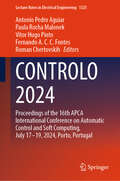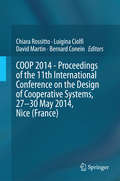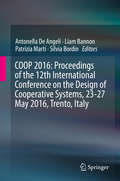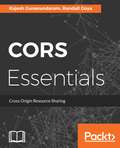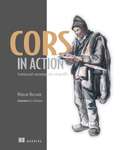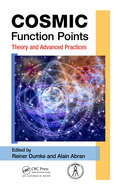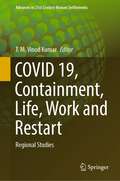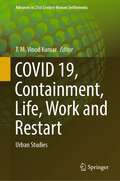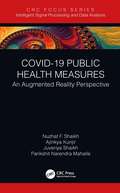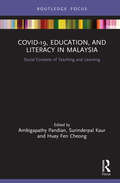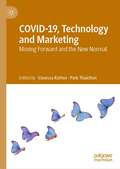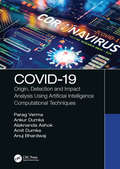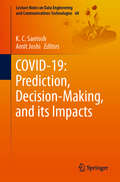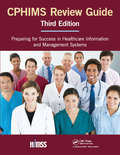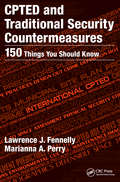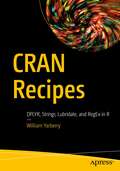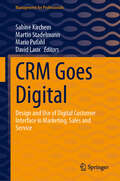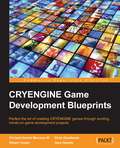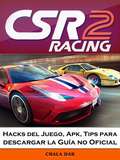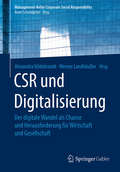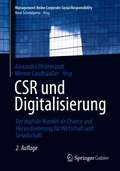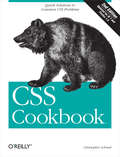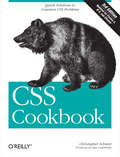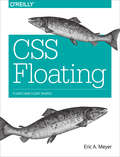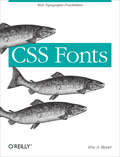- Table View
- List View
CONTROLO 2024: Proceedings of the 16th APCA International Conference on Automatic Control and Soft Computing, July 17-19, 2024, Porto, Portugal (Lecture Notes in Electrical Engineering #1325)
by Paula Rocha Malonek Antonio Pedro Aguiar Vítor Hugo Pinto Fernando A. C. C. Fontes Roman ChertovskihThis book offers a perfect insight of the latest research and developments in the fields of dynamic systems and control engineering. Gathering the proceedings of the 16th APCA International Conference on Automatic Control and Soft Computing (CONTROLO 2024), held on July 17-19, 2024, in Porto, Portugal, this volume covers a wide range of theoretical and practical issues relating to the development and use of different control approaches, such as PID control, adaptive control, non-linear control, intelligent monitoring and control based on fuzzy and neural systems. Further topics include robust control systems, and real time control. Sensors and actuators, measurement systems, renewable energy systems, aeronautic and aerospace systems, as well as industrial control and automation, are also comprehensively covered. All in all, this book offers a timely and thoroughly survey of the latest research in the fields of dynamic systems and automatic control engineering, and a source of inspiration for researchers and professionals worldwide.
COOP 2014 - Proceedings of the 11th International Conference on the Design of Cooperative Systems, 27-30 May 2014, Nice (France)
by David Martin Luigina Ciolfi Chiara Rossitto Bernard ConeinThis volume presents the proceedings of the 11th International Conference on the Design of Cooperative Systems (COOP 2014). The conference is a venue for multidisciplinary research contributing to the design, assessment and analysis of cooperative systems and their integration in organizations, public venues, and everyday life. COOP emerged from the European tradition of Computer Supported Cooperative Work (CSCW) and Cognitive Ergonomics as practiced in France These proceedings are a collection of 28 papers reflecting the variety of research activities in the field, as well as an increasing interest in investigating the use and design of ICT in all aspects of everyday life and society, and not merely in the workplace. The papers represent a variety of research topics, from healthcare to sustainable mobility to disaster response, in settings from all over the world. For the first time, the proceedings include papers presented in an Early-Career Researchers Track which was organized in order to give young researchers the opportunity to discuss their work with an international community. This collection of papers provides a picture of new developments and classic topics of research around cooperative systems, based on the principle that a deep knowledge of cooperative practices is a key to understanding technology impacts and producing quality designs. The articles presented will appeal to researchers and practitioners alike, as they combine an understanding of the nature of work with the possibilities offered by novel digital technologies.
COOP 2016: Proceedings of the 12th International Conference on the Design of Cooperative Systems, 23-27 May 2016, Trento, Italy
by Antonella De Angeli Liam Bannon Patrizia Marti Silvia BordinThis volume presents the proceedings of the 12th International Conference on the Design of Cooperative Systems (COOP 2016). The conference is a venue for multidisciplinary research contributing to the design, assessment and analysis of cooperative systems and their integration in organizations, public venues, and everyday life. COOP emerged from the European tradition of Computer Supported Cooperative Work (CSCW) and Cognitive Ergonomics. A collection of 22 papers and 4 workshop overviews are presented, reflecting the variety of research activities in the field of the design of cooperative systems with a special emphasis on "Making Together" This collection offers a broad vision of collective working practices and cooperative design, embracing the idea that design requires a deep understanding of collective activities, involving both artefacts and social practices within a context. The result is a rich and articulated debate that widens the design space towards the exploration of a variety of forms of participation and engagement in collaborative system design. Experienced researchers, academics, designers and practitioners who are interested in collaborative design theory and methods would be interested in the state of the art research and case studies this collection provides.
CORS Essentials
by Rajesh Gunasundaram Randall GoyaWeb developers have been limited by the Same Origin Policy and often wish they could spread their application across different domains. You know JavaScript and AJAX, and have run up against the Same Domain Policy, which is limiting your applications.
CORS in Action: Creating and consuming cross-origin APIs
by Monsur HossainSummaryCORS in Action introduces Cross-Origin Resource Sharing (CORS) from both the server and the client perspective. It starts with the basics: how to make CORS requests and how to implement CORS on the server. It then explores key details such as performance, debugging, and security. API authors will learn how CORS opens their APIs to a wider range of users. JavaScript developers will find valuable techniques for building rich web apps that can take advantage of APIs hosted anywhere. The techniques described in this book are especially applicable to mobile environments, where browsers are guaranteed to support CORS. Purchase of the print book includes a free eBook in PDF, Kindle, and ePub formats from Manning Publications. About the BookSuppose you need to share some JSON data with another application or service. If everything is hosted on one domain, it's a snap. But if the data is on another domain, the browser's "same-origin" policy stops you cold. CORS is a new web standard that enables safe cross-domain access without complex server-side code. Mastering CORS makes it possible for web and mobile applications to share data simply and securely. CORS in Action introduces CORS from both the server and the client perspective. It starts with making and enabling CORS requests and then explores performance, debugging, and security. You'll learn to build apps that can take advantage of APIs hosted anywhere and how to write APIs that expand your products to a wider range of users. For web developers comfortable with JavaScript. No experience with CORS is assumed.What's InsideCORS from the ground upServing and consuming cross-domain dataBest practices for building CORS APIsWhen to use CORS alternatives like JSON-P and proxiesAbout the AuthorMonsur Hossain is an engineer at Google who has worked on API-related projects such as the Google JavaScript Client, the APIs Discovery Service, and CORS support for Google APIs.Table of ContentsPART 1 INTRODUCING CORSThe Core of CORSMaking CORS requestsPART 2 CORS ON THE SERVERHandling CORS requestsHandling preflight requestsCookies and response headersBest practicesPART 3 DEBUGGING CORS REQUESTSDebugging CORS requests APPENDIXESCORS referenceConfiguring your environmentWhat is CSRF?Other cross-origin techniques
COSMIC Function Points: Theory and Advanced Practices
by Alain Abran Reiner DumkeDesigned to conform to the ISO/IEC standard 14143, the Common Software Measurement International Consortium (COSMIC) Function Point method has become the major estimation technique based on international standards for building software-intensive systems. COSMIC Function Points: Theory and Advanced Practices supplies a cutting-edge look at current a
COVID 19, Containment, Life, Work and Restart: Regional Studies (Advances in 21st Century Human Settlements)
by T. M. Vinod KumarThis book is about containment, life, work, and restart regions affected by COVID 19, using selected empirical case studies. This book presents the spread of coronavirus spatially and temporally, analyses containment strategies and includes recommended strategies. Further, it analyses how life and work get transformed during the lockdown, and gradual opening up, and presents the future of work and life in cities impacted by COVID-19. This book discusses the concept of smart life and works in cities post-COVID-19 such that they do not reduce the quality of work and life and cannot create adverse economic and living consequences called the restart of a city after COVID-19.Selected Regions of special interest are studied. Special interest is because Kerala and Maharashtra got the worst affected in India by COVID 19 pandemic and the book focus on that.
COVID 19, Containment, Life, Work and Restart: Urban Studies (Advances in 21st Century Human Settlements)
by T. M. Vinod KumarThis book is about containment, life, work, and restart cities affected by COVID 19, using selected empirical case studies. This book presents the spread of coronavirus spatially and temporally, analyses containment strategies and includes recommended strategies. Further, it analyses how life and work get transformed during the lockdown, and gradual opening up, and presents the future of work and life in cities impacted by COVID-19. This book discusses the concept of smart life and works in cities post-COVID-19 such that they do not reduce the quality of work and life and cannot create adverse economic and living consequences called the restart of a city after COVID-19.Selected Cities of special interest are studied. Special interest is because Kerala and Maharashtra got the worst affected in India by COVID 19 pandemic and the book focus on that.
COVID-19 Public Health Measures: An Augmented Reality Perspective (Intelligent Signal Processing and Data Analysis)
by Nuzhat F. Shaikh Ajinkya Kunjir Juveriya Shaikh Parikshit Narendra MahalleConsidering the overall situation of the current pandemic and pertinent recommendations, this book focuses on the use of augmented reality (AR) applications for preventing COVID-19 outbreaks along with techniques, tools, and platforms to achieve social distancing.and sanitization. COVID-19 Public Health Measures: An Augmented Reality Perspective contains theoretical and practical knowledge of AR and remedies on how to cope with the pandemic, including multiple use cases along with a set of recommendations. This book illustrates application building using open-source software with an interactive interface to aid impaired users. The initial part of this book emphasizes the basic knowledge of AR, technology, devices, and rest of the relevant theories. This book is aimed at researchers, students of AR, technical healthcare professionals, and practitioners. Key Features: • Consists of an extensive introduction to the terminologies and components of AR • Provides in-depth knowledge of various tools and techniques used in AR • Introduces various platforms and software development kits (SDKs) such as Unity Engine, Unreal Engine, and Vuforia • Gives a step-by-step guide for the development of an AR app • Describes how AR can be used specifically by impaired users not only in the situation of current pandemic but also in normal situations thus simplifying day-to-day activities
COVID-19, Education, and Literacy in Malaysia: Social Contexts of Teaching and Learning (COVID-19 in Asia)
by Surinderpal Kaur Huey Fen Cheong Ambigapathy PandianPart of a mini series of Focus books on COVID-19 in Malaysia, the chapters in this book address the pandemic’s impacts on education and literacy. Covering a range of teaching and learning challenges impacting learners and teachers, the contributors highlight the pervasiveness of the pandemic on Malaysian society and how Malaysians have found ways to cope. They focus mainly on students’ COVID-19 narratives, digital and health literacy issues, language and new vocabulary. This is an opportunity to witness how researchers from multiple disciplines can join forces during challenging times. There are a great many lessons to be learned from the successes and failures in responding to the pandemic and the measures that have been necessary to contain it. A fascinating read for scholars and educators with an interest in crisis management in non-Western contexts, especially those with a particular interest in Malaysia, or Southeast Asia more generally.
COVID-19, Technology and Marketing: Moving Forward and the New Normal
by Vanessa Ratten Park ThaichonThis book addresses how Covid-19 has damaged businesses and how businesses can adapt to the new normal. In doing so, the book contributes to theories associated with the marketing management, by assessing opportunities and challenges associated with the implementation of technology and marketing management during and post Covid-19.Although there is increasing research in consumer or business management acceptance of new technologies and digital marketing, the impact of these on marketing management during the Covid-19 are not adequately investigated, leading to overstated hypothetical predictions of its future potential. Chapters in the book therefore focus on new economic models such as sharing economy and business structures such as omnichannel, where advancements have enabled firms to build a one-on-one relationship with customers by collecting, storing, aggregating and analysing customer information across various touchpoints. Contributions in the book also focus on new technologies such as blockchain, automation solution, information technology management, and customer relationship management (CRM) in highlighting connections between these new technologies and marketing management.The book will be useful for anyone aiming to gain a better understanding of the current and future technologies that may play a role or have a robust impact on marketing management during Covid-19.
COVID-19: Origin, Detection and Impact Analysis Using Artificial Intelligence Computational Techniques
by Ankur Dumka Alaknanda Ashok Parag Verma Amit Dumka Anuj BhardwajThis book highlights progress in terms of Virus Biology and Infection Detection, Prevention, and Control, along with Screening, Testing, and Detection Techniques, that will provide learners and researchers (from basic to advanced) with the most innovative computer-driven methodologies for the fight against COVID-19. In addition, this book also covers the Pre- and Post-Impact of the COVID-19 Pandemic Crisis that will definitely provide useful content for researchers to think broadly about the analytical areas affected by COVID-19. This ultimately shows different paths to the same destination to help understand the nature of the COVID-19 pandemic and how to avoid it in the future.
COVID-19: Prediction, Decision-Making, and its Impacts (Lecture Notes on Data Engineering and Communications Technologies #60)
by Amit Joshi K. C. SantoshThis book outlines artificial intelligence for COVID-19 issues that are ranging from prediction to decision-making for healthcare support in human lives. Starting with major COVID-19 issues and challenges, it takes possible AI-based solutions for multiple problems, such as early prediction, its role for public health, detection of positive cases, drug analysis, and healthcare support. It mainly employs publicly available data (population) to predict who should be tested for COVID-19, for example, radiological image data to detect COVID-19 positive cases from other similar and/or different manifestations, such as pneumonia, distributed healthcare support, and supply chains in the middle of COVID-19 pandemic. The book includes recently developed AI-driven tools and techniques, such as pattern recognition, anomaly detection, machine learning, and data analytics. It covers a wide range of audience from computer science and engineering to healthcare professionals.
CPHIMS Review Guide: Preparing for Success in Healthcare Information and Management Systems (HIMSS Book Series)
by HimssWhether you're taking the CPHIMS exam, or simply want the most current and comprehensive overview in healthcare information and management systems today - this completely revised and updated third edition has it all. But for those preparing for the CPHIMS exam, this book is an ideal study partner. The content reflects the exam content outline covering healthcare and technology environments; systems analysis, design, selection, implementation, support, maintenance, testing, evaluation, privacy and security; and administration leadership management. Candidates can challenge themselves with the sample multiple choice questions at the end of the book.
CPTED and Traditional Security Countermeasures: 150 Things You Should Know
by Lawrence Fennelly Marianna PerryCTPED and Traditional Security Countermeasures: 150 Things You Should Know is a handy reference for both seasoned professionals and those just starting out in security and law enforcement. Crime Prevention Through Environmental Design (CPTED) is a foundational concept to physical security and can be incorporated widely in security policies, plans, and procedures. It has proven effective over the many years insofar as building and campus design, security architecture, and creating an overall security culture in any workplace. The authors have collected a broad array of topics together, garnered through their many years of real-world experience in the field. Security solutions that address a wide range of physical security challenges are presented in an easy to follow format. Security practitioners and law enforcement professionals alike will find practical tips to understand and manage their security program, including access control, target hardening, command and control, physical security protections, and visitor management, among a myriad of other topics. This will be a must-have reference for professionals looking for real-world recommendations for physical security solutions.
CRAN Recipes: DPLYR, Stringr, Lubridate, and RegEx in R
by William YarberryWant to use the power of R sooner rather than later? Don’t have time to plow through wordy texts and online manuals? Use this book for quick, simple code to get your projects up and running. It includes code and examples applicable to many disciplines. Written in everyday language with a minimum of complexity, each chapter provides the building blocks you need to fit R’s astounding capabilities to your analytics, reporting, and visualization needs. CRAN Recipes recognizes how needless jargon and complexity get in your way. Busy professionals need simple examples and intuitive descriptions; side trips and meandering philosophical discussions are left for other books. Here R scripts are condensed, to the extent possible, to copy-paste-run format. Chapters and examples are structured to purpose rather than particular functions (e.g., “dirty data cleanup” rather than the R package name “janitor”). Everyday language eliminates the need to know functions/packages in advance. What You Will LearnCarry out input/output; visualizations; data munging; manipulations at the group level; and quick data explorationHandle forecasting (multivariate, time series, logistic regression, Facebook’s Prophet, and others)Use text analytics; sampling; financial analysis; and advanced pattern matching (regex)Manipulate data using DPLYR: filter, sort, summarize, add new fields to datasets, and apply powerful IF functionsCreate combinations or subsets of files using joinsWrite efficient code using pipes to eliminate intermediate steps (MAGRITTR) Work with string/character manipulation of all types (STRINGR)Discover counts, patterns, and how to locate whole wordsDo wild-card matching, extraction, and invert-matchWork with dates using LUBRIDATEFix dirty data; attractive formatting; bad habits to avoid Who This Book Is For Programmers/data scientists with at least some prior exposure to R.
CRM Goes Digital: Design and Use of Digital Customer Interface in Marketing, Sales and Service (Management for Professionals)
by Mario Pufahl Martin Stadelmann Sabine Kirchem David LauxCustomer management has taken on entirely new forms since digitalization. This brand-new CRM book is dedicated to the latest approaches that dominate sales, marketing, and service in this era of digitalization. Topics include Omni-Channel or mobile CRM concepts, Big Data and social media tools, new customer experience or loyalty approaches, and Artificial Intelligence, etc. In this forward-looking, practice-oriented, and conceptually sound customer relationship management book, readers will learn about future developments in customer management using digital CRM (dCRM), product, and service optimization. The book also focuses on sales management and the improvement of sales performance through radical customer orientation. The chapters are written by, and for, academic, consulting, and company experts who appreciate a theoretical and practical approach to the topic.
CRYENGINE Game Development Blueprints
by Richard Gerard Marcoux III Chris GoodswenPerfect the art of creating CRYENGINE games through exciting, hands-on game development projects About This Book * Create CRYENGINE games from scratch with CRYENGINE Blank Game Starter-kit * Discover good working practices and tips to quickly jump into making a new level in the game * Build practical game projects and discover advanced concepts of CRYENGINE game development using the examples in the book Who This Book Is For This book is intended for CRYENGINE game developers, wanting to develop their skills with the help of industry experts. A good knowledge level and understanding of CRYENGINE is assumed, to allow efficient programming of core elements and applications. What You Will Learn * Create a CRYENGINE game from scratch with the Game Starter-kit * Add custom methods to allow the player/AI to use a weapon * Create complete "start" and "end" game menus using Scaleform and C++ * Discover how to use highpoly modeling workflow and techniques within the pipeline for the SDK to use * Use the Crytiff exporter from Photoshop * Export the CHR--the format the engine needs to read the skeleton * Integrate the character in the engine using the character tool * Better understand the rules to create and author skeletons to rig characters designed for CRYENGINE * Debug common setup issues that might appear during production with useful tools In Detail CRYENGINE is a game engine developed by Crytek for PC, Playstation, Xbox, Android, and iOS. It can be used to create AAA games, movies, high-quality simulations, and interactive applications. It is most popularly used for game development. In this book, you will start off by exploring the CRYENGINE "Blank" Game Starter-kit, creating a completely playable character from scratch and controlling its movement. You will learn how to implement a weapon and ammo class, and will create complete "start" and "end" game menus using Scaleform and C++. Additionally, you will learn some key texturing techniques for PBR and how to create and bake maps to the lowpoly model. You will also explore how to get a static model from Maya and shaders setbup in the SDK to check the textures during creation, and create all the necessary engine files to export and see the game character's animations in your engine. In the final third of the book, you will learn how to create objectives, set up saved games, layer on audio polish to help immerse the player in the experience, and debug game issues. Style and approach An easy-to-follow, practical guide covering three exciting projects. As you work through each project you will explore new topics including complex animation, advanced scripting, and complex character motion. All the code used in each project is explained in detail.
CSR Racing 2 Hacks del Juego, Apk, Tips para descargar la Guía no Oficial
by Joshua Abbott Emmanuel Castro HernándezCSR Racing 2 es la continuación de CSR Racing, y finalmente ha llegado. Lanzado por Zynga y Natural Motion. Aunque parece el mismo que la primera versión (carreras de arranques, mejorando tu propio coche y comprando otros) es, de hecho, diferente. Así que estamos aquí para ayudarte mientras te damos trampas, tips y trucos por escrito, ¡especialmente para este juego! Sólo recuerda, no uses esos tips en la vida real. ¡te meterías en problemas!
CSR und Digitalisierung: Der digitale Wandel als Chance und Herausforderung für Wirtschaft und Gesellschaft (Management-Reihe Corporate Social Responsibility)
by Alexandra Hildebrandt Werner LandhäußerDieses Buch ist ein Kaleidoskop unserer Gesellschaft und Zeit. Es besch#65533;ftigt sich mit Herausforderungen, Chancen und Risiken der gr#65533;#65533;ten Transformation der Geschichte: der Digitalisierung. Vorgestellt werden bahnbrechende neue Methoden zur nachhaltigen Steuerung der digitalen Transformation, neue Denkstile sowie neue Formen interdisziplin#65533;rer Zusammenarbeit - etwa mit Geistes-, Sozial- und Naturwissenschaftlern, #65533;konomen, Informatikern, Psychologen, Philosophen und Vertretern der Kreativwirtschaft. Sie zeigen, dass Digitalisierung weder gef#65533;rchtet noch verehrt werden muss, denn es geht vor allem darum, ihre Rolle zu verstehen, um sie nachhaltig zu gestalten.
CSR und Digitalisierung: Der digitale Wandel als Chance und Herausforderung für Wirtschaft und Gesellschaft (Management-Reihe Corporate Social Responsibility)
by Alexandra Hildebrandt Werner LandhäußerIn der 2. Auflage des Buches "CSR und Digitalisierung" werden zwei Jahrhundertthemen zusammengeführt, die die wichtigsten Fragen unserer Zeit bündelnWie können wir ökologisch und sozial verantwortlich wirtschaften?Welche Rolle kann und soll die Digitalisierung dabei spielen? Die Digitalagenda ist die erste Strategie in Europa, die Digitalisierung und Umweltschutz konsequent miteinander verbindetDas vorliegende Buch ist allerdings auch eine Erweiterung der hier angesprochenen Themen, denn viele der vorgeschlagenen Maßnahmen basieren auf „weichen“ Instrumenten. Gezeigt wird u. a., welche aktuellen Maßnahmen und Methoden zur nachhaltigen Steuerung der digitalen Transformation die besten Unternehmen und Organisationen einsetzen, aber auch, dass es heute neue Denkstile sowie neue Formen interdisziplinärer Zusammenarbeit braucht. Digitalisierung muss weder gefürchtet noch verehrt werden, denn es geht vor allem darum, ihre Rolle zu verstehen, um sie nachhaltig zu gestalten. Finden Sie Beiträge unter anderem von:Franz Alt, Wolfgang Schäuble, Judith Gerlach, Timotheus Höttges, Olaf Koch, Henning Kagermannm, Christian Seifert, Manuel Neukirchner, Jutta Rump
CSS Cookbook
by Christopher SchmittAs the industry standard method for enriching the presentation of HTML-based web pages, Cascading Style Sheets (CSS) allow you to give web pages more structure and a more sophisticated look. But first, you have to get past CSS theory and resolve real-world problems. For those all-too-common dilemmas that crop up with each project, CSS Cookbook provides hundreds of practical examples with CSS code recipes that you can use immediately to format your web pages. Arranged in a quick-lookup format for easy reference, the second edition has been updated to explain the unique behavior of the latest browsers: Microsoft's IE 7 and Mozilla's Firefox 1.5. Also, the book has been expanded to cover the interaction of CSS and images and now includes more recipes for beginning CSS users. The explanation that accompanies each recipe enables you to customize the formatting for your specific needs. With topics that range from basic web typography and page layout to techniques for formatting lists, forms, and tables, this book is a must-have companion, regardless of your experience with Cascading Style Sheets.
CSS Cookbook: Quick Solutions to Common CSS Problems (Animal Guide)
by Christopher SchmittLearn how to solve the real problems you face with CSS. This cookbook offers hundreds of practical examples for using CSS to format your web pages, and includes code samples you can use right away. You'll find exactly what you need, from the basics to complex hacks and workarounds.Each recipe explains how to customize a solution to meet your needs, and each chapter features a sample design that showcases the topics discussed. You'll learn about the behavior of the latest browsers-including IE 8, Firefox 3, Safari 4, and Google Chrome—and how you can resolve differences in the ways they display your web pages. Arranged in a convenient format for quick reference, this third edition is a valuable companion for anyone working with CSS.Learn the basics, such as the CSS rule structureWork with web typography and page layoutCreate effects for images and other page elementsLearn techniques for configuring lists, forms, and tablesDesign effective web navigation and create custom linksGet creative by combining CSS with JavaScriptLearn useful troubleshooting techniquesExplore features of HTML5 and CSS3
CSS Floating: Floats and Float Shapes
by Eric A. MeyerWhile flowing text around images is certainly nothing new, with CSS you can float any element, from images to paragraphs to lists. In this practical guide, author Eric Meyer reveals some interesting—and surprising—ways to use CSS floats in your web design, including the latest capability to flow content past non-rectangular float shapes.Short and sweet, this book is an excerpt from the upcoming fourth edition of CSS: The Definitive Guide. When you purchase either the print or the ebook edition of CSS Floating, you’ll receive a discount on the entire Definitive Guide once it’s released. Why wait? Learn how to bring life to your web pages now.Learn the characteristics of floated elements, and CSS rules for using themBe aware of certain rule exceptions when applying floats to your design, including the use of negative marginsUse the clear property to prevent floats from affecting elements in the next section of the documentCreate floating boxes in non-rectangular shapes, including rounded corners, circles, ellipses, and even polygonsDefine float shapes with transparent or opaque images
CSS Fonts: Web Typography Possibilities
by Eric A. MeyerFrom custom fonts to ad-hoc font families you assemble out of a variety of individual faces, CSS 3 gives you more typographic options than ever before. This concise guide shows you how to use CSS properties to gain a fine-grained and wide-ranging influence over how you display fonts on the Web.Short and sweet, this book is an excerpt from the upcoming fourth edition of CSS: The Definitive Guide. When you purchase either the print or the ebook edition of Fonts, you’ll receive a discount on the entire Definitive Guide once it’s released. Why wait? Learn how to choose and manipulate fonts right away.Specify font families and their generic alternativesUse @font-face to specify customized downloadable fontsSize your fonts with absolute or relative scales, percentages, or length unitsUnderstand the difference between italic and oblique stylesLearn how to specify or suppress a font’s kerning data and other font featuresSynthesize your own variants for fonts that lack bold or italic text
